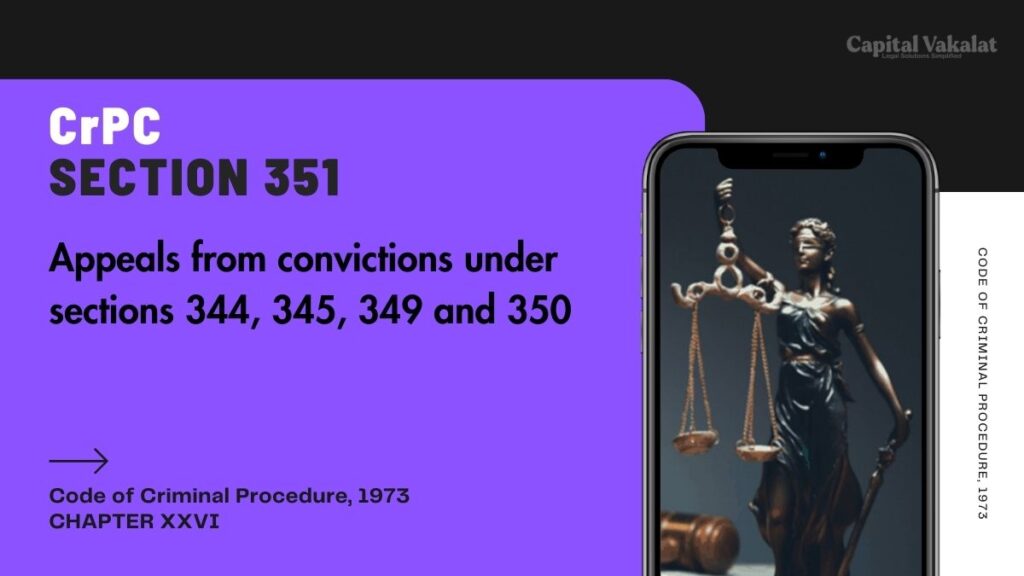In the intricate tapestry of criminal law, the right to appeal stands as a cornerstone of justice. Section 351 of the Criminal Procedure Code (CRPC) provides a critical avenue for those convicted under specific sections to seek redress. Appeals from convictions under sections 344, 345, 349, and 350 hold significant weight in ensuring that justice is not only done but seen to be done.

This article delves into the nuances of Section 351 CRPC, offering a comprehensive guide to understanding and navigating the appeals process.
Understanding Section 351 CRPC
The Importance of Appeals
Appeals are pivotal in the legal system as they provide a mechanism for correcting errors, addressing grievances, and ensuring that the law is applied fairly. Without the ability to appeal, a single judicial decision would be final, potentially leading to miscarriages of justice. Section 351 CRPC exemplifies the legal system’s commitment to fairness and rectitude.
Scope and Application
Section 351 specifically addresses appeals from convictions under sections 344, 345, 349, and 350. These sections pertain to various offenses and the procedures for handling contempts of lawful authority. The appeals process under Section 351 is designed to review and potentially overturn convictions that may have been unjustly administered.
Historical Context
Evolution of Appeal Rights
The right to appeal has evolved significantly over the centuries. In ancient legal systems, the concept of appealing a decision was virtually non-existent. However, modern legal frameworks recognize the necessity of a multi-tiered judicial process. The incorporation of appeal rights within the CRPC reflects this evolution, ensuring a robust system of checks and balances.
Appeals from Convictions
Specifics of Sections 344, 345, 349, 350
- Section 344 deals with the procedure when a person does not comply with a bond.
- Section 345 addresses the power to deal with contempt of court.
- Section 349 pertains to the procedure in certain cases of contempt.
- Section 350 outlines the procedure when a person appears in response to a proclamation.
Understanding these sections is crucial for comprehending the types of convictions that can be appealed under Section 351 CRPC.
Legal Framework
The Structure of Appeals under Section 351
The appeals process is meticulously structured to ensure that every appellant receives a fair hearing. This includes the submission of an appeal application, the examination of the grounds for appeal, and a detailed review by a higher court. The framework is designed to be thorough, providing multiple layers of scrutiny.
Procedures for Filing Appeals
Step-by-Step Guide
- Filing the Notice of Appeal: The first step is to file a notice of appeal within the stipulated time frame.
- Preparation of Appeal Grounds: Detailed grounds for the appeal must be prepared, outlining the errors or injustices in the original conviction.
- Submission of Documents: All relevant documents, including the judgment being appealed, must be submitted.
- Hearing: A higher court will schedule a hearing where both the appellant and the respondent can present their cases.
- Decision: After reviewing the case, the court will issue its decision, which could affirm, reverse, or modify the original judgment.
Grounds for Appeal
Common Reasons and Justifications
Appeals can be based on various grounds, including procedural errors, misinterpretation of the law, insufficient evidence, or new evidence that could potentially exonerate the appellant. Each ground requires a thorough examination to determine its validity.
The Role of Legal Representation
Importance of Hiring a Lawyer
Navigating the appeals process can be complex and daunting without professional legal assistance. Lawyers play an essential role in preparing the case, presenting arguments, and ensuring that the appellant’s rights are protected throughout the process.
Challenges in the Appeal Process
Common Obstacles and Solutions
The appeals process is not without its challenges. Common obstacles include procedural delays, the burden of proving significant errors in the original trial, and limited access to new evidence. However, these challenges can be mitigated through diligent preparation, expert legal counsel, and a clear understanding of the procedural requirements.
Case Studies
Landmark Judgments
Examining landmark judgments can provide valuable insights into how appeals under Section 351 CRPC are handled. These cases often highlight the complexities involved and the judicial reasoning behind overturning or upholding convictions.
The Role of the Judiciary
Ensuring Fairness in Appeals
The judiciary plays a pivotal role in ensuring that the appeals process is fair and just. Judges must meticulously review each case, considering all relevant factors before making a decision. This role underscores the importance of an impartial and competent judiciary in upholding the principles of justice.
Impact on Defendants
Legal and Personal Implications
Appealing a conviction can have profound legal and personal implications for defendants. A successful appeal can lead to exoneration, while an unsuccessful one can reinforce the original conviction. Understanding these implications is crucial for defendants considering an appeal.
Comparative Analysis
Appeals in Other Jurisdictions
Comparing the appeals process under Section 351 CRPC with those in other jurisdictions can provide a broader perspective. Different legal systems have varying approaches to appeals, and understanding these differences can highlight the strengths and weaknesses of the CRPC framework.
Future Directions
Potential Reforms
As with any legal framework, there is always room for improvement. Potential reforms to the appeals process under Section 351 CRPC could include streamlining procedures, improving access to legal representation, and enhancing the transparency of judicial decisions.
Conclusion
Section 351 CRPC serves as a vital instrument in the pursuit of justice, providing a structured process for appealing convictions under sections 344, 345, 349, and 350. By understanding the legal framework, procedures, and potential challenges, individuals can better navigate the appeals process. Ensuring fairness and rectitude in criminal justice is paramount, and the right to appeal is a critical component of this endeavor.